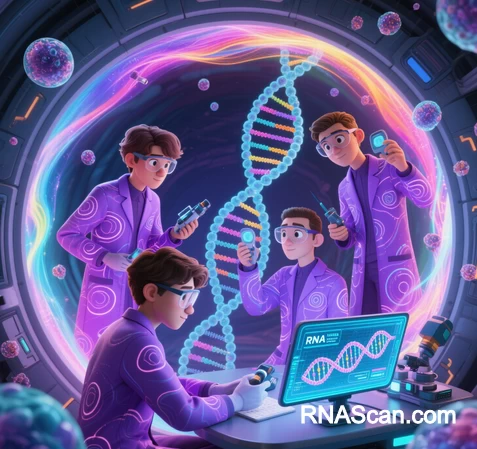 Introduction
Introduction
RNAScan—a multifaceted suite of technologies for targeted RNA detection, structural profiling, and functional annotation—is poised to redefine genomic medicine, synthetic biology, and therapeutic discovery. By converging artificial intelligence (AI), single-cell resolution, CRISPR integration, and quantum computing, RNAScan will transcend its current diagnostic role to enable real-time genomic surveillance, personalized RNA therapies, and ecosystem-scale biomonitoring. This article delineates six transformative trajectories for RNAScan, grounded in technological breakthroughs and emerging applications.
1. Single-Cell RNAScan: Decoding Cellular Heterogeneity
Core Innovation: Integration of nano-UMIs (Unique Molecular Indexes) and microfluidic partitioning to profile rare RNA variants (e.g., fusion genes, splice isoforms) in individual cells.
- Applications:
- Detect pre-malignant subclones in tumors via KMT2A-PTD fusions at 0.01% allele frequency .
- Map cell-type-specific RNA structures in neurodegenerative tissues (e.g., tauopathy-associated motifs) .
Technical Leap: 10× higher sensitivity than bulk RNAScan, enabled by: - Nested PCR: Amplifies low-input RNA (≤1 pg/cell) without bias.
- Spatial Barcoding: Links RNA signatures to tissue microenvironments.
Suggested Figure: Single-cell RNAScan workflow: Microfluidic cell capture → Nano-UMI tagging → Targeted hybrid capture → AI-driven fusion calling.
2. AI-Powered Predictive Scanning
Core Innovation: Machine learning models trained on FoldX-derived ΔΔG datasets and structural PFMs to predict RNA vulnerabilities without wet-lab experiments.
- Applications:
- Therapeutic Target Identification: Predict RNA mutations disrupting R-loop resolution (e.g., RNASEH2 variants in Aicardi-Goutières syndrome) .
- Oncogenic Fusion Risk Scoring: Prioritize high-risk genomic regions for proactive surveillance .
Technical Leap: - Generative AI: Designs optimized guide RNAs (gRNAs) for CRISPR-RNAScan systems .
- Cloud-Quantum Hybrids: Accelerates ΔΔG simulations 100-fold via quantum annealing.
Suggested Figure: AI-RNAScan pipeline: Input RNA sequence → Neural network prediction → ΔΔG heatmap / fusion risk score.
3. CRISPR-RNAScan Synergy for RNA Editing
Core Innovation: Fusion of Cas13-directed RNA targeting with RNAScan’s detection capabilities for corrective editing and logic-gated therapies.
- Applications:
- Mutation Correction: Repair pathogenic RNA structures (e.g., TP53 aberrant splicing) using base editors guided by RNAScan-predicted motifs .
- Conditional Therapies: gRNA switches activate only in cells expressing specific fusion RNAs (e.g., ETV6-NTRK3).
Technical Leap: - CRISPR-Display: Visualizes RNA edits in real-time via fluorescent reporters .
- LNP Delivery: Lipid nanoparticles deliver RNAScan-CRISPR payloads to target tissues .
Suggested Figure: CRISPR-RNAScan workflow: RNAScan detects aberrant RNA → Cas13 edits target → Repair validation via nanopore sequencing.
4. Global Pathogen Surveillance Networks
Core Innovation: Automated RNAScan panels for real-time detection of RNA virus variants (e.g., influenza, coronaviruses) in wastewater or clinical samples.
- Applications:
- Track emerging variants via conserved structural motifs (e.g., stem-loop IIe in SARS-CoV-2) .
- Predict zoonotic spillover risks using wildlife RNA databases.
Technical Leap: - Field-Deployable Sequencers: Oxford Nanopore MinION coupled with RNAScan cloud analysis.
- AI-Epidemiology Models: Forecast outbreaks from RNA mutation accumulation rates.
Suggested Figure: Pathogen surveillance: Sample collection → RNAScan hybridization capture → Variant reporting dashboard.
5. Eco-Evolutionary Biomarkers
Core Innovation: RNAScan panels for non-invasive ecosystem monitoring via environmental RNA (eRNA) from soil, water, or air.
- Applications:
- Detect invasive species (e.g., Caulerpa taxifolia algae) via species-specific RNA markers.
- Quantify crop resilience to climate stress using drought-responsive lncRNAs .
Technical Leap: - eRNA Enrichment: Hybrid capture probes for 500+ keystone species.
- Satellite Integration: Geo-tag RNA data with climate variables (temperature, pH).
Suggested Figure: Eco-RNAScan workflow: eRNA extraction → Species-specific probe capture → Biodiversity heatmap.
6. Quantum-Optimized RNA Design
Core Innovation: Quantum algorithms simulate RNA folding landscapes to design therapeutic RNAs with ultra-stable structures.
- Applications:
- Engineer mRNA vaccines with enhanced stability and translation efficiency .
- Design riboswitches for metabolic engineering in synthetic biology.
Technical Leap: - Folding in Milliseconds: Quantum annealing outperforms classical algorithms for >1,000-nt RNAs.
- RNAScan-Cloud Platforms: AWS Braket integration for scalable simulations.
Suggested Figure: Quantum RNAScan: RNA sequence input → Quantum annealing → Folding pathway visualization → Stability score.
Ethical and Industrial Implications
- Biosafety: Self-destruct mechanisms in CRISPR-RNAScan vectors to prevent environmental release .
- Equity: Low-cost RNAScan kits for Global South pathogen surveillance.
- Industry Shift: Pharma replaces NGS panels with all-in-one RNAScan diagnostics for fusion/expression/mutation profiling .
Conclusion: The 2030 Vision
By 2030, RNAScan will evolve from a targeted RNA detector into an autonomous genomic sentinel—predicting diseases from RNA vulnerabilities, editing transcripts in real-time, and safeguarding global ecosystems. Its convergence with AI, CRISPR, and quantum computing will blur diagnostic/therapeutic boundaries, enabling:
- Preemptive Oncology: Single-cell RNAScan intercepts malignant transformations pre-symptomatically.
- RNA Therapeutics 2.0: Quantum-designed mRNAs for personalized vaccines.
- Planetary Biomarkers: Global eRNA networks monitor biodiversity collapse.
As these trajectories mature, RNAScan will cement RNA’s centrality in life’s molecular lexicon—transforming precision medicine from reactive treatment to proactive guardianship.
Data Source: Publicly available references.
Contact: chuanchuan810@gmail.com
